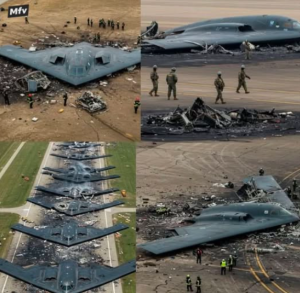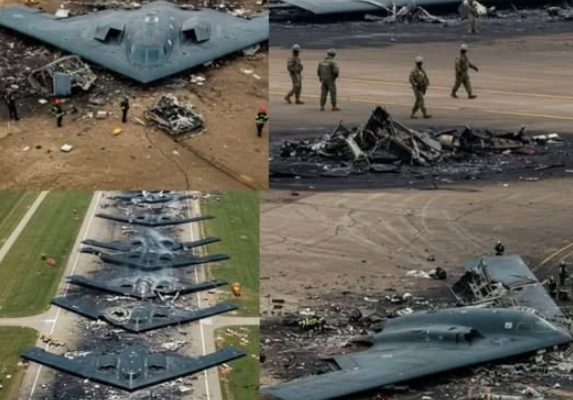The B-2 Spirit, often called the “Stealth Bomber,” is one of the most advanced aircraft in the United States Air Force, capable of flying undetected into hostile airspace and striking high-value targets with precision. Its missions are long, demanding, and often shrouded in secrecy. Among these, the notion of a nonstop 37-hour mission to Iran and back represents the extreme limits of both human endurance and aircraft capability, combining the precision of advanced aviation technology with the grit, discipline, and resilience of its pilots.
For B-2 pilots, every mission begins long before wheels lift off the runway. Detailed briefings cover everything from geopolitical intelligence to meteorological data. A mission to Iran, in particular, requires meticulous planning: airspace restrictions, surface-to-air threats, enemy radar coverage, and potential interception routes are analyzed with precision. Pilots study satellite imagery, review past intelligence reports, and coordinate with multiple command centers to ensure that the path to the target—and the return journey—is as safe as possible. The stakes are immense: a misstep could compromise the mission, the aircraft, or even international security.
Once airborne, the B-2 enters a realm of intense operational discipline. The aircraft is designed for stealth, with a radar-evading shape and special coatings that make it virtually invisible to enemy defenses. However, piloting a B-2 is no simple matter. The bomber is highly sensitive, responding to subtle inputs with precision. Pilots must maintain constant vigilance, monitoring systems, altitude, speed, and navigation while coordinating with ground control. On a 37-hour mission, fatigue becomes a silent adversary, threatening reaction times, judgment, and focus. To counter this, crews employ strict schedules, including shifts for monitoring systems, rest periods, and careful management of hydration and nutrition.
A nonstop mission of such duration requires extensive use of aerial refueling. The B-2 is designed for long-range operations, but even its impressive 6,000-mile range is insufficient for a round trip to Iran from bases in the continental United States. Midair refueling operations are complex and high-risk, demanding perfect timing, steady flight, and seamless coordination with tanker aircraft. Each refueling point is preplanned down to the minute, with contingency plans in place for weather deviations or mechanical issues. These moments, though routine in training, carry heightened tension during actual combat missions because any delay can ripple across the remainder of the flight schedule.
Beyond the technical demands, the psychological strain on pilots is immense. A 37-hour mission is not just a test of skill; it is a test of endurance, discipline, and mental resilience. Sleep deprivation sets in quickly, and the human body is forced to adapt to unnatural rhythms. Pilots rely on brief naps, controlled breathing, and mental exercises to remain alert. The cabin, though spacious compared to fighter jets, offers little comfort. The faint hum of avionics, the occasional flicker of warning lights, and the knowledge that the mission involves entering hostile airspace all combine to create an intense cognitive environment. Every decision, from adjusting altitude to executing navigation corrections, carries significant consequences.
As the B-2 approaches Iranian airspace, stealth becomes paramount. Radar avoidance and electronic countermeasures are critical to mission success. Pilots must navigate through potentially hostile zones without detection, relying on precision instruments and preprogrammed flight paths. The terrain below, varying from deserts to urban landscapes, offers no comfort or distraction; it is both a reference point and a constant reminder of the risks involved. During this phase, communication with command is minimized to prevent electronic detection, placing full responsibility on the crew. Every second is scrutinized, every adjustment calculated, and every system continuously monitored.
The strike phase, assuming this hypothetical mission includes a bombing objective, would involve careful coordination with onboard targeting systems. The B-2 is capable of delivering conventional or nuclear ordnance, and precision is critical. Pilots must maintain a delicate balance between remaining undetected and achieving accurate deployment. For a mission of this duration, the technical demands multiply: fatigue can affect judgment, environmental conditions can impact targeting systems, and the high stakes demand flawless execution. Even minor errors could compromise the mission, jeopardize the aircraft, or endanger lives.
After completing the target engagement, the return journey begins, bringing its own challenges. Pilots must retrace thousands of miles, still avoiding detection, managing systems, and conserving fuel until refueling points are reached. Each hour brings cumulative fatigue, making concentration even more critical. Psychological resilience is tested as the crew endures monotony, stress, and physical strain. Onboard routines—checking systems, monitoring weather, and adjusting flight paths—become both a necessity and a coping mechanism, providing structure during prolonged isolation at 50,000 feet.
A 37-hour mission also demands rigorous attention to human factors. Nutrition is carefully planned, typically consisting of high-protein, energy-dense meals that can be consumed quickly and with minimal mess. Hydration is critical, as the dry cabin air and prolonged hours can deplete the body rapidly. Pilots must manage bathroom breaks and comfort issues while remaining seated and alert, often using specially designed suits and equipment to accommodate such extreme durations. Mental endurance is supported by exercises in visualization, scenario planning, and situational awareness to maintain alertness despite exhaustion.
Upon nearing home base, relief is tempered by the realization that the mission is not yet complete. The landing phase, particularly after such prolonged hours, requires precision and calm. Pilots must counter fatigue, manage descent protocols, and ensure the aircraft is safely on the ground. The final moments in the cockpit are a mix of satisfaction, exhaustion, and reflection, knowing the mission tested the limits of human and machine alike. Post-flight debriefings involve detailed analysis of every phase, from navigation and refueling to target engagement and stealth management. Lessons learned inform future operations, training, and risk mitigation.
Ultimately, a nonstop 37-hour mission in a B-2 Spirit represents the pinnacle of modern military aviation. It is a test of technology, human endurance, and operational coordination on an unprecedented scale. Such missions underscore the complexity of strategic air operations, the risks faced by pilots, and the extraordinary capabilities of modern stealth aircraft. They are a blend of meticulous planning, advanced engineering, and human resilience, pushing both machine and operator to the edge.
The story of a B-2 crew flying such a mission is as much about courage and skill as it is about technology. It highlights the dedication required to operate one of the world’s most advanced aircraft under extreme conditions. It illustrates the tension between human endurance and mechanical capability, the fine line between success and disaster, and the unwavering commitment of pilots who undertake missions that test the limits of both body and mind. In the annals of modern aviation, such an operation is a testament to precision, resilience, and the extraordinary reach of strategic airpower.

